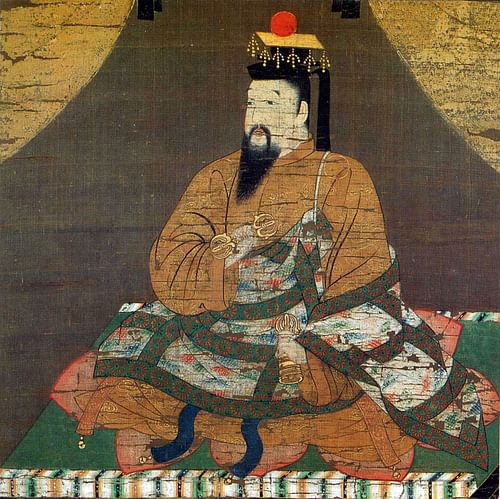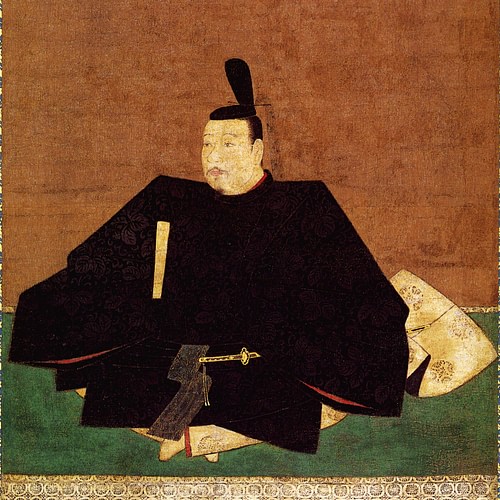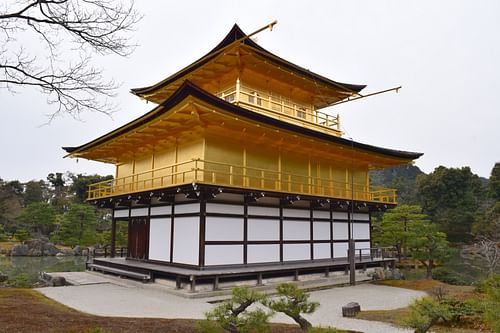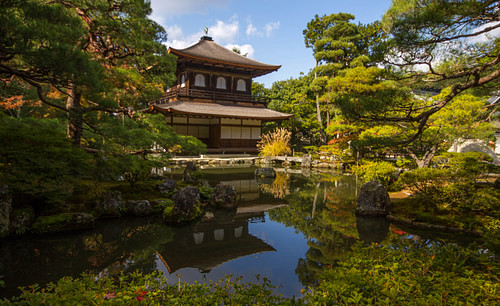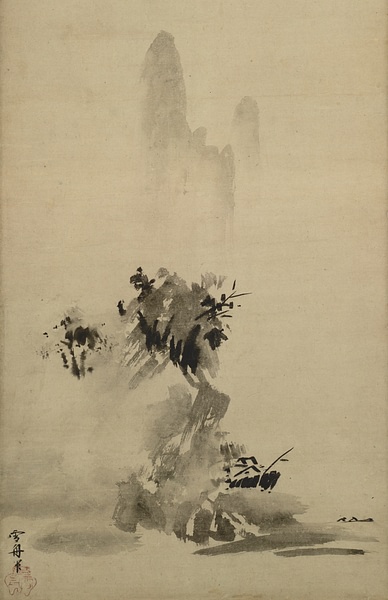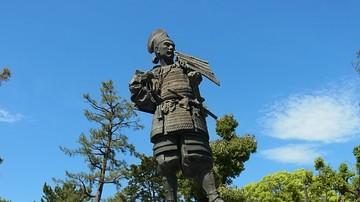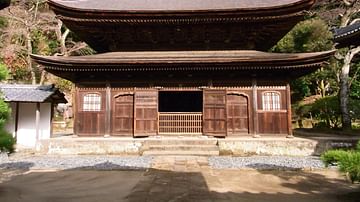
The Muromachi Period (Muromachi Jidai, 1333-1573 CE) refers to the period of Japanese medieval history when the Ashikaga shogun capital was located in the Muromachi area of Heiankyo (Kyoto). Replacing the Kamakura Shogunate (1192-1333 CE), the Ashikaga or Muromachi Shogunate (1338-1573) would oversee a depressingly warlike, rebellious, and brutal period of history which saw incessant rivalries between warlords and unchecked bandits plaguing the countryside. There were a few bright spots such as the construction of the Kinkakuji and Ginkakuji temples in Kyoto as well as progress in trade and commerce, the arts and castle architecture. The period ended with the warlord Oda Nobunaga seizing power in 1568 CE and his decision to exile the last Ashikaga shogun in 1573 CE.
The Kamakura Period
The Kamakura period spanned from 1185 to 1333 CE and began when the military leader Minamoto no Yoritomo took control of Japan. In 1192 CE Yoritomo selected Kamakura as the new capital of the Kamakura Shogunate with the imperial court still residing at Heinakyo (Kyoto). The shoguns (military dictators) would redistribute land to loyal followers but also instigate reforms which improved trade and agriculture. The development of Zen Buddhism in Japan would be another feature of the Kamakura period.
Several attempts were made by emperors in the period to regain some of the power they had lost to the shoguns that ruled Japan in practice. Emperor Go-Daigo (r. 1318-1339 CE) stirred up rebellion, as he had unsuccessfully tried to do in 1324 and 1331 CE, and used his allies, the rebel warlords Nitta Yoshisada (l. 1301-1337 CE) and Ashikaga Takauji to topple the Kamakura shoguns. The Kamakura Shogunate had been seriously weakened by the Mongol invasions of Kublai Khan (r. 1260-1294 CE) in 1274 and 1281 CE. Both invasions failed, largely thanks to two typhoons destroying the invasion fleets. However, the conflict and the standing in readiness between the invasions (including awaiting an anticipated third attack that never came) nearly brought the state to bankruptcy. Unrest from unpaid samurai and a general lack of control in the provinces, which lead to widespread banditry, meant that the Kamakura shoguns were at their most vulnerable.
The Kenmu Restoration
Around 1333 CE Kamakura was sacked by Nitta Yoshisada, and the capital was moved back to join the imperial court of Heiankyo. With the government established in the Muromachi district of the city, the decision gave its name to the next period of Japanese history: the Muromachi period. There then followed the incident known as the Kenmu Restoration (1333-1336 CE). Ashikaga Takauji had been sent by the Kamakura Shogunate to deal with Go-Daigo but, tempted by the power his army offered him, he joined forces with the emperor and attacked Heiankyo. Takauji wanted to be nothing less than the new shogun, but Go-Daigo refused to give him this title because he did not want to return to a position of subservience. Takauji then defeated Go-Daigo's chief ally Yoshisada at the battle of Minatogawa near Kobe in July 1336 CE and then captured Heiankyo. The chaos and fighting of the 1330s CE were wryly noted by an anonymous sign painter in Heiankyo:
Assaults in the night, armed robberies, falsified documents, easy women…chopped off heads, monks who defrock themselves and laymen who shave their heads.
(Huffman, 43)
Go-Daigo was exiled for a second time, but he established his own court anyway at Yoshino, 95 kilometres (60 miles) south of Heiankyo. Ashikaga Takauji found himself a more compliant emperor, Komyo (r. 1336-1348 CE), to act as the state's figurehead and became shogun in 1338 CE, thus inaugurating the Ashikaga Shogunate (aka Muromachi Shogunate) which would rule Japan until 1573 CE. One loose end was Go-Daigo as there were now two emperors in Japan, a system known as the 'Dual Courts' or 'Northern and Southern Courts' (divided by the major and minor imperial lines rather than mere geography), which would not be resolved until 1392 CE when the southern court ceased to exist after a promise was made and then broken to alternate emperors between the two lines.
The Ashikaga Shogunate
The Ashikaga Shogunate got off to a poor start and set the tone for much of the period when Ashikaga Takauji's rivalry with his brother Tadayoshi broke out in a war that lasted from 1350 to 1352 CE. Takauji was victorious, and Tadayoshi was poisoned, a fate most likely arranged by his brother.
The system of government of the Ashikaga Shogunate followed much the same lines as the Kamakura Shogunate with a few additions. The position of deputy shogun (kanrei) was created as a liaison between the shogun and regional governors. A specific oversight of Kamakura was deemed advisable to make sure the Hojo family did not make a comeback, and this task was put into the hands of the Kanto deputy. Other regions were also considered a risk to the central government and so there was a similar deputy to supervise the regions of northwest Honshu and Kyushu.
Perhaps ironically for a period known for its general lawlessness, the Ashikaga shoguns did add a few extras to Japan's established law codes. Ashikaga Takuiji added 17 articles which mostly dealt with the expected behaviour of samurai. The articles were largely based on the principles famously expressed by Prince Shotoku (regent of Japan from 594 to 622 CE) in his own 17-article constitution. Another new development was the idea that not only should convicted criminals be punished but also their families and even the communities in which they lived. This idea of collective responsibility was called renza (or enza) and sometimes resulted in people connected to the criminal receiving the same punishment. Whether the system reduced crime is a moot point but it did result in communities trying to resolve criminal cases before they came to the attention of the central authorities.
The shogunate held control of the central part of Japan, and the bureaucracy at the capital was relatively efficient, but the outer provinces were left semi-independent as local warlords (daimyo) ruled their own lands how they saw fit. Local officials and estate managers such as the jito found it much more difficult to secure the taxes the state was due from landlords who had no fear of any government reprisals. The state was obliged to find other means to fill its coffers and these strategies often did much to boost the economy as landowners and temples tried their hand at money-lending, the number of small businesses grew (especially brewers and distillers), and the government raked off their share through taxes. Another money-spinning scheme was to introduce tolls on roads and impose fees on temples. International trade also did well with Japan joining the Chinese Ming Dynasty's tribute system from 1401 CE. The Ming emperor even recognised the shogun as the 'king of Japan' in return, and goods were exchanged between the two states. Ming porcelain, silk, and bronze coins were popular while finely-worked swords, copper ore, and timber went in the other direction.
Agriculture, despite the upheaval of the wars and occasional famines caused by the vagaries of weather which plagued the period, continued to thrive in the longer-term thanks to innovations like double-cropping and the use of fertilizers which had begun in the Kamakura period. Villages grew in number and size as farmers sought security in numbers and worked together to produce more and benefit from communal projects such as digging irrigation channels and building waterwheels. In the absence of any authority from the central government, villages governed themselves. Small councils or so were formed which made decisions regarding laws and punishments, organised community festivals, and decided on regulations within the community. Some villages got together to form leagues or ikki for their mutual benefit.
Farmers generally did well in the period, and slavery all but disappeared, but women enjoyed fewer rights than under the Kamakura with, for example, a convention being established that brides join the household of their husbands whom, along with their mother-in-law, they were obliged to obey. Although women could still inherit property, there was a return to the convention that the oldest male inherited the family estate in order to reduce the fragmentation of land into parcels too small to be useful for different siblings.
In 1543 CE the first European contact was made with Japan when three Portuguese traders had their Chinese junk ship blown onto its shores by a storm. Landing on the island of Tanegashima, southern Kyushu, they brought with them firearms which the Japanese adopted. More Europeans followed, including Christian missionaries, the most famous being Francis Xavier, a Spanish Jesuit who came to Kagoshima in 1549 CE. The new religion was sometimes enthusiastically adopted by daimyo as it often proved a ticket to greater trade relations with the Europeans sailing the East Asian seas.
The Onin War
The Onin War (1467-1477 CE) was a civil war with its name deriving from the year period. The timespan of the war and its long aftermath is often called the Sengoku period or Warring States period (1467-1568 CE). It was a time, as the period's name would suggest, of bitter rivalries, fighting and treachery amongst Japan's rival warlords and samurai, which brought hardship, robbery, and brutality to the doorstep of many ordinary people. Japan seemed at war with itself and its rulers bent on destruction. One anonymous poem, composed c. 1500 CE, captures the general mood of the times:
A bird with
One body but
Two beaks,
Pecking itself
To death.
(Henshall, 243)
The cause of the decade-long Onin War was, at least initially, the bitter rivalry between the Hosokawa and Yamana family groups, but in the end, it sucked in most of the influential clans and destroyed most of Heiankyo. The conflict revolved around each side backing a different candidate for the position of shogun - a particularly pointless debate since shoguns no longer had any real power. Rather, the war is seen by historians as merely a result of the overly aggressive warlords of Japan, the most powerful daimyo, being rather too keen to put their samurai to some use - good or bad. Even when the war ended in 1477 CE there was no victor and no resolution to the inherent militarism that fractured Japan for the next century as warlords fought each other with no one in particular ever achieving any dominance.
Architectural & Cultural Achievements
Many important buildings were constructed during the Muromachi period. The Kinkakuji or 'Temple of the Golden Pavilion' - so called because of its shimmering gilded exterior - was built in Heiankyo in 1397 CE, followed by its twin, the Ginkakuji or 'The Serene Temple of the Silver Pavilion', completed in 1483 CE. Both were originally retirement estates for former shoguns but were each converted into Buddhist temple sites. Another converted private estate, also in Kyoto, is Ryoanji (1473 CE), which now has the most-visited Zen rock garden in Japan.
Another development of the period was the establishment of the tearoom and the Japanese Tea Ceremony. The Tea Ceremony had been introduced to Japan much earlier by Zen Buddhist monks but it now became, thanks to the combined efforts of the monk Murato Shuko (1422-1502 CE) and the shogun Ashikaga Yoshimasa (r. 1449-1473 CE), the restrained and precise ceremony that we know today as chanoyu. The setting was crucial and so sparsely furnished tearooms were added to the villas of the well-off in order to provide a calming space in which to perform the ceremony.
Other lasting cultural pursuits which sprang up during the period included early forms of flower arranging and Noh theatre, both of which also had roots in religious ceremonies and temple practices. The Zen religion would even have a significant influence on painting, epitomised by the work of the Zen priest Sesshu (real name Toyo, 1420-1506 CE) who specialised in suiboku, that is using only black ink and water on white paper scrolls, in a style that has been described as an austere form of impressionism with its ordinary landscape subjects depicted in monochrome. Sesshu's work is widely considered amongst the finest ever produced by a Japanese painter of any period.
Finally, because of the constant threat of war and pillage in the Muromachi period, castles were built with much greater frequency than previously in towns, at mountain passes, and on larger estates. The latter type, which could take the form of fortified mansions, were known as yashiki; Ichijodani (base of the Asakura family) and the moated Tsutsujigasaki (of the Takeda family) were excellent examples of this building trend. Some castles, such as Omi-Hachiman near Lake Biwa, caused an entire town to later spring up around them, the jokomachi. Not as yet the grand multi-storied stone structures of later centuries, the castles of the period were, nevertheless, often sophisticated defensive structures despite the predominant use of wood. Constructed on large stone bases, the wooden superstructures included walls, towers, and gates, which had narrow windows for archers and from which hung boulders on ropes, ready to be dropped on any attackers.
Decline & Oda Nobunaga
The end of the Muromachi period came when the Ashikaga Shogunate was terminated by the warlord Oda Nobunaga (l. 1534-1582 CE). Oda Nobunaga had expanded his territory gradually through the 1550/60s CE from his base at Nagoya Castle as he defeated all comers. He finally seized Heiankyo in 1568 CE and then exiled the last Ashikaga shogun, Ashikaga Yoshiaki, in 1573 CE. Yoshiaki, who had in any case always been Nobunaga's puppet, was technically still the shogun until 1588 CE but he had no power as warlords now dominated the government and country. Nobunaga would rule over a much more unified central Japan until his death in 1582 CE. The unification of the country would continue under his immediate successors, Toyotomi Hideyoshi (1537-1598 CE) and Tokugawa Ieyasu (1543-1616 CE). This next period of Japan's history would be known as the Azuchi-Momoyama Period (1568/73-1600 CE).
This content was made possible with generous support from the Great Britain Sasakawa Foundation.
